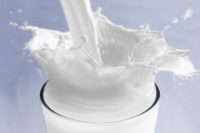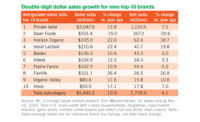
A Fluid Situation
Designed for efficiency, maintenance and sanitation, pumps, valves and fittings deliver on customer demand.
by Lynn Petrak
The product development
and marketing side of the dairy business may command a lot of attention,
but items wouldn’t get out the door and into consumers’ hands
without a properly run production line.
Pumps, valves and fittings, which ensure the flow of
product throughout various processes, have been core components for
decades. New models have been driven by a variety of factors, from
processors’ desire to adhere to Pasteurized Milk Ordinance (PMO)
standards to speed and efficiency concerns to maintenance issues, like
clean-in-place (CIP) features and protection against corrosion.
“Processors are increasingly seeking to
incorporate efficient processing, and therefore incorporate efficient
processing equipment. There has been a continual shift towards such
equipment as automated valves, automated double-block-and-bleed systems,
like mixproof valves and high-efficiency centrifugal and positive
displacement pumps,” observes Mark Larsen, vice president and general
manager, sanitary segment, for Alfa Laval Inc., Pleasant Prairie, Wis., a
supplier of components and full-service process system designs.
The changing nature of dairy processing has impacted
pumps, valves and fittings, as companies expand their product offerings.
“Viscous products have always been a challenge to processors.
Products like low-shear rotary lobe pumps and long-stroke single-seat
valves have aided processors in efficiently moving viscous product through
the dairy,” Larsen says.
Basic production capability aside, budget concerns are
at the center of any operation. “Processors want to reduce costs by
automating their process, and are demanding more flexibility from their
valve systems to allow higher asset utilization,” explains Jack
Jordan, president of Südmo North America, Rockford, Ill., which
provides a full line of aseptic and product-safe valves and fittings.
Bill Duyser, marketing and corporate trainer for
Bradford Fittings, a Pewaukee, Wis.-based division of Dixon Valves and
Couplings, agrees. “What is changing is that processors are looking
to reduce costs and one way to do that is by eliminating people. Then you
have to have something to do that job, so automation is a big part of
that,” he says. “You not only automate just one valve, but a
section of valves to do things.”
Indeed, the long-term value of high-performing pumps,
valves and fittings is becoming a key concern in equipment upgrades.
“There is a greater awareness of the total cost of ownership for a
piece of equipment. Most sophisticated processors are realizing that the
initial price of a pump or piece of equipment may be a relatively small
portion of their total cost over the life of that product,” says
Bruce Smith, regional sales manager for Middleton, Wis.-based Fristam Pumps
USA, citing recent industry research. “In fact, a DuPont survey of
pump costs showed that the purchase price represented only 4 percent of the
lifetime operational cost.”
Other trends driving improvements in pumps, valves and
fittings include cleaning capability, especially given greater emphasis on
sanitation standards, some of which has been driven by PMO requirements and
voluntary HACCP programs. “Companies are looking for stainless steel
for washdown, so they have longevity,” Duyser says.
Scott Dillner, marketing director, Americas, for
Delavan, Wis.-based SPX Process Equipment Co., manufacturer of Waukesha
Cherry-Burrell products, cites the usual factors of cleanability, ease of
maintenance and dependability as reasons dairy plants invest in new
equipment, but points to another recent impetus. “Safety and security
— that has been even more evident in the last three to four
years,” he says, adding that SPX now offers material traceability on
its products.
Although many companies that upgrade pumps, valves and
fittings do so because the existing parts are worn or not working properly,
often changes in the entire system are made. “Some see efficiencies
by upgrading all at once. Others cannot afford large upgrades or
significant downtimes, so they’ll upgrade as they can,” reports
Larsen.
Others agree that renovations depend on plant
circumstances. “In my experience, most upgrades take place as part of
capital projects that are justified on the basis of increased capacity,
cost savings or the ability to provide new products or packages,”
says Smith.
Adds Dillner: “We’ve found that processors
generally upgrade when required with various components. It occurs all at
once if a new line is being installed or if an existing line is being
overhauled.”
Consolidation within the dairy industry has impacted
operators who decide to pursue the latest machinery and parts. “Some
larger dairies are building larger automated facilities and closing down
smaller operations to get the cost benefits,” observes Jordan.
“Some companies were forced to invest because their plant
efficiencies were so low.”
Pumped Up
Several suppliers have introduced new models of pumps
and various support features over the past year. SPX, for example, recently
launched several new pumps including the Tru-Fit PD pump, which offers
self-aligning shafts where a coupling and guard are not required. “It
eliminates high maintenance costs, reduces base plate length by an average
of 20 to 25 percent and has improved cleanability over traditional pump
packages,” explains Dillner.
Fristam’s new models include a new FPR
centrifugal pump, featuring an internal seal with as few as half the number
of components. “The FPR responds to customer requests for simpler
design and easier maintenance,” Smith says. “The seal is
front-loading so customers can change it without moving the pump, and there
are fewer parts to inventory.”
In 2004, Minneapolis-based Graco Inc. debuted a
series of quick knockdown Husky sanitary diaphragm pumps, designed to meet the
increasingly stringent requirements of the dairy industry. Created to
accommodate flow rates up to 150 gpm, the Husky 3150 models are available
with ball check models, which can pass solids up to 1 inch, and flapper
checks, which can pass solids up to 2.5 inches, says Brian Welborn, product
marketing manager.
Other features of the self-priming Husky 3150 pumps,
Welborn says, include lube-free operation, tri-clamp connections and a
superior air valve with a 15-year warranty. In addition, Graco’s
pumps are available with Santoprene®, Buna-N, Viton® and PTFE diaphragms, and can be sent stand-mounted or
in 55-gallon or 300-gallon unloader packages.
Valuable Valves
SPX recently introduced a PMO mixproof valve, which
Dillner says is a direct result of demand for PMO-compatible equipment in
Grade A plants. “It’s durable and machined from bar
construction. It also has an independent seat lifting actuation, and a
standard balanced lower plug,” he says.
Alfa Laval’s Unique Mix Proof Valve was designed
to handle large-curd cheese applications, among other functions. “The
4-inch valve enables modern, high-volume cheese producers to move
product quickly and efficiently,” Larsen says. “With the
Unique’s ‘double-block-and-bleed’ mixproof design,
you’re able to stream two different products or CIP fluids through
the same valve at the same time – without risk of cross
contamination.” In addition, Larsen says, processors can increase
yield through repeatable sanitary processing and quicker maintenance.
SPX has developed new Y-Body valves, with a full-port
design that minimizes pressure loss for large particulates and allows for
extra-long stroke to lift valve plugs out of the flow area.
Südmo, too, has been busy on the design side.
“Our new ARC valve allows for a 3-A solution for a full-bore,
automatically cleanable valve similar to the manual clean plug valves. This
valve can now interface with pigging systems, particulates and viscous
products while having the ability to clean in place,” says Jordan.
The valve has applications for products like ice cream, cottage cheese and
heavy sauces.
Südmo also recently improved its single-seat
valve line. Recently, the supplier began offering a mechanical stop that
allows a standard shut-off valve to open to a variable, locked position.
“This allows processors to accurately batch products with reduction
in errors which results in costs savings,” Jordan says.
New Britain, Conn.-based Parker’s Fluid Control
Division has developed a new series of Sinclair Collins SC-2000
piston-operated check valves to its current lineup of equipment, which
includes process control and solenoid valves. The new stainless-steel check
valves are available in a variety of models and with multiple port sizes,
and were designed to withstand pressures of up to 500 psi with reduced
cracking pressure.
Control-top technology has been another area of
interest in valve design. Südmo has developed the new IntelliTop that
offers a more robust control top featuring a stainless-steel cover. The
control top was created to send the automation system a signal for valve
maintenance as well as other feedback variables. “This saves the
processor maintenance costs and increases efficiencies by faster
trouble-shooting” Jordan says.
Likewise, SPX now offers improved control top
features. The company recently unveiled new Set & Forget Valve Control
Top Technology, which eliminates the need to adjust micro switches or
proximity switches.
Suppliers have worked on more efficient actuator
components of valve systems as well. Bradford Fittings, for instance, has
developed cylinder-style and vertical-style actuators to work with its ball
valve designs. Duyser says dairies have been opting more for
stainless-steel components for washdown and reliability.
Keenly aware that time is money, meanwhile, Bradford
is also set to offer custom accessories. “We now have custom-designed
bracketry for all of our valves and actuators that we can ship in a 24-hour
period,” Duyser says.
Fitting Ending
Modern designs for fittings increasingly reflect
manufacturers’ demands for cleanability. Indeed, traditional fitting
areas can be tricky to clean thoroughly and consistently.
Along with its series of valves, Bradford Fittings
recently unveiled new bevel seat fittings, clamp fittings and heavy duty
I-line fittings.
Alfa Laval supplies several types of fittings for
dairy applications, too. The company’s Tri-Clover models are most
often used in dairy settings, especially with corrosion-resistant
finishes. Dairy customers also have installed Alfa Laval’s
Tri-Weld and Bevel Seat fittings for various dairy plant uses.
Lynn Petrak is a freelance journalist based in the
Chicago area.
$OMN_arttitle="A Fluid Situation";?>
